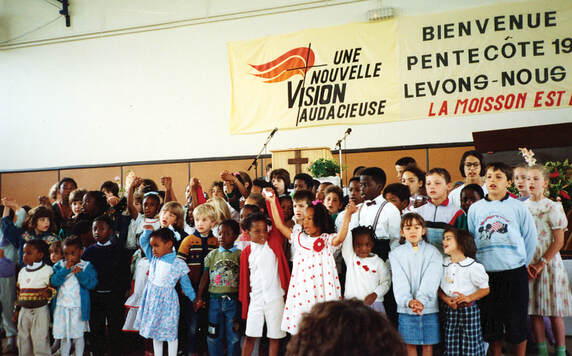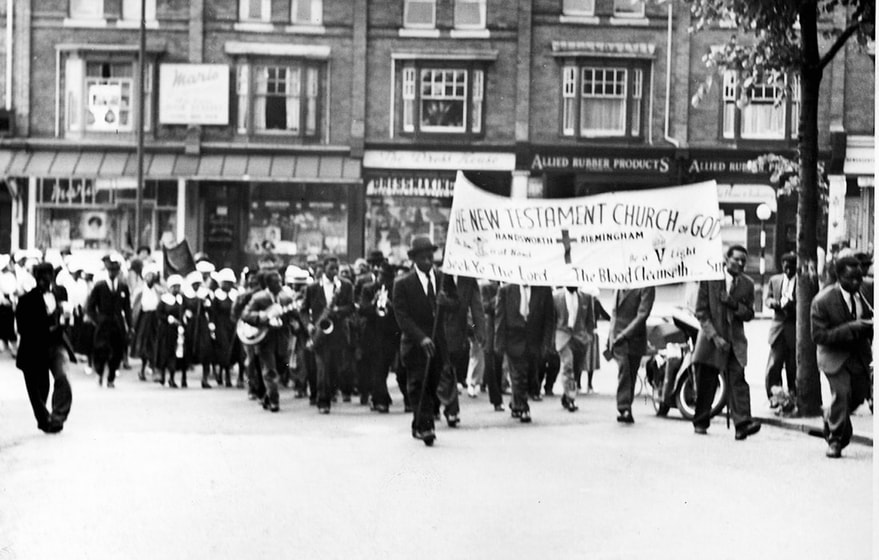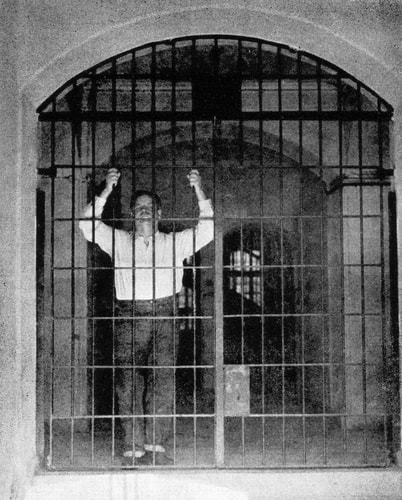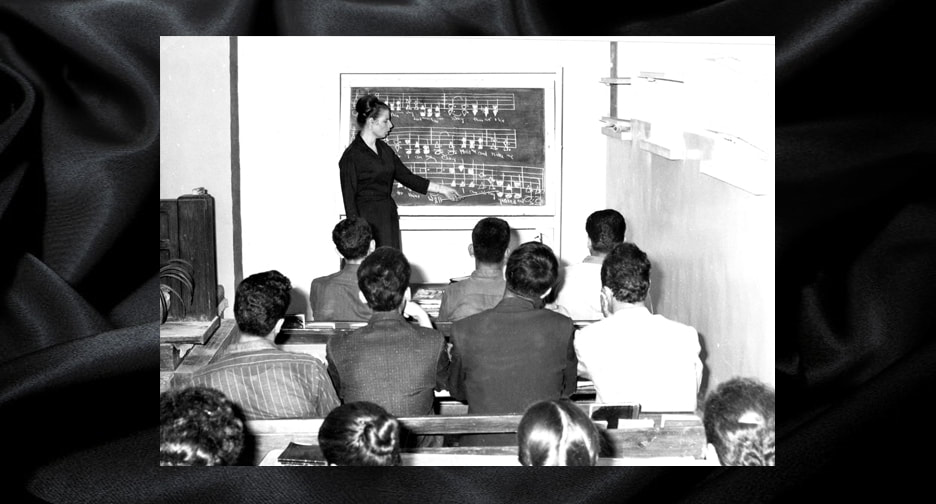EUROPE, EURASIA, & THE MIDDLE EAST
Louis F. Morgan
THE STORY OF the Church of God in Europe, Eurasia, and the Middle East is primarily a movement spread by immigrants and national workers who have ministered despite persecution.
Romania’s Apostolic Church of God
Romania is the earliest link the Church of God has with Europe. In 1922, Sida Bradin lay ill with tuberculosis in Paulis Village, Arad, Romania, when she and her husband, Gheorge, received materials explaining the gifts of the Holy Spirit and healing. This ignited their faith, they prayed, and Sida was healed. They received additional literature in the Romanian language published by the Church of God and requested more information. Paul Budean, a Romanian immigrant ministering in Michigan and Ohio, answered the Bradins’ letter and explained Pentecostal beliefs. Bradin became the first Pentecostal pastor in Romania and established a church in September 1922. By 1924, the Romanian government censored the church, but Budean made a trip there to minister and baptized the first converts in the Mures River late at night. Often members walked for miles to worship in secret, but the church continued to grow and has been known as the Apostolic Church of God since 1929.
Trandafir Sandru, who began preaching by age 10, remembered when government control limited religious practices. In 1941, he was baptized in water, which was forbidden. Summoned to testify against the man who baptized him, Sandru refused to swear the oath before testifying and was released. He believed divine intervention delivered him from certain conviction as others had been sentenced to prison for their baptism. Sandru later established a seminary in 1976, known today as the Pentecostal Theological Institute in Bucharest. He also was influential in helping secure the fellowship agreement in 1980 between the Pentecostal Apostolic Church of God in Romania and the Church of God.
Freedom of worship was granted to Romanian churches after World War II, and open-air meetings were held in 1946 with 139 baptized in water. The following year Sandru reported, “[O]ur organization is one of the most important Protestant churches in Romania. This year, about 550 souls received their water baptism… Praise the Lord! The Pentecostal Movement is very powerful here.” During political changes in the late 1980s, many Romanians migrated and established thriving congregations in other parts of the world, including North America. Moses Ardelean now leads the Romanian Apostolic Church of God, which is considered Europe’s largest Pentecostal body.
Romania is the earliest link the Church of God has with Europe. In 1922, Sida Bradin lay ill with tuberculosis in Paulis Village, Arad, Romania, when she and her husband, Gheorge, received materials explaining the gifts of the Holy Spirit and healing. This ignited their faith, they prayed, and Sida was healed. They received additional literature in the Romanian language published by the Church of God and requested more information. Paul Budean, a Romanian immigrant ministering in Michigan and Ohio, answered the Bradins’ letter and explained Pentecostal beliefs. Bradin became the first Pentecostal pastor in Romania and established a church in September 1922. By 1924, the Romanian government censored the church, but Budean made a trip there to minister and baptized the first converts in the Mures River late at night. Often members walked for miles to worship in secret, but the church continued to grow and has been known as the Apostolic Church of God since 1929.
Trandafir Sandru, who began preaching by age 10, remembered when government control limited religious practices. In 1941, he was baptized in water, which was forbidden. Summoned to testify against the man who baptized him, Sandru refused to swear the oath before testifying and was released. He believed divine intervention delivered him from certain conviction as others had been sentenced to prison for their baptism. Sandru later established a seminary in 1976, known today as the Pentecostal Theological Institute in Bucharest. He also was influential in helping secure the fellowship agreement in 1980 between the Pentecostal Apostolic Church of God in Romania and the Church of God.
Freedom of worship was granted to Romanian churches after World War II, and open-air meetings were held in 1946 with 139 baptized in water. The following year Sandru reported, “[O]ur organization is one of the most important Protestant churches in Romania. This year, about 550 souls received their water baptism… Praise the Lord! The Pentecostal Movement is very powerful here.” During political changes in the late 1980s, many Romanians migrated and established thriving congregations in other parts of the world, including North America. Moses Ardelean now leads the Romanian Apostolic Church of God, which is considered Europe’s largest Pentecostal body.
 Children worshiping at a 1996 convention in France
Children worshiping at a 1996 convention in France
Europe’s Multicultural Ministry
Immigrants from the Caribbean introduced the Church of God to England and Wales. Oliver Lyseight moved to England from Jamaica in 1951 and began evangelizing. Soon other Caribbean members arrived and assisted him. By 1955, congregations were in Wolverhampton and Birmingham, and the work progressed quickly. The first Anglo-British congregation was started in Hitchin in 1981 by English minister Brian Barnett. Joe Kurian, whose roots are in India, has helped establish ethnic churches among Indians, South Asians, Romanians, Nigerians, and others. As in the Caribbean, the church in Britain is known as the New Testament Church of God.
The work in Greece was first established through the efforts of Herodotus Kourpas, a taxi driver, and has expanded to include ethnic churches among Filipinos and Romanians. The work in France began when Herman Lauster organized a church in 1959 among German immigrants in Alsace. The following year the first French church was organized in Troyes by French minister André Weber, who first learned about the Church of God from J.H. Saayman of South Africa.
Belgium is a model multicultural church. Beginning with a congregation founded by Italian-American missionaries Gilbert and Edith Scotti that aligned with the Church of God in 1973, Belgium’s multicultural work was initiated six years later when John and Michelle Tijerina planted a church in Brussels. John, a Mexican-American, and Michelle, a Belgian, quickly connected with immigrants from the African Congo. Under the leadership of Martin Mutyebele, the church increased its multicultural influence. Today, it is the largest Protestant congregation in Belgium and includes many nationalities.
In the Netherlands, the lasting work was started among Dutch Indonesians and a Chinese Indonesian radiologist associated with the Full Gospel Bethel Church in Indonesia; in Austria among Romanian refugees; in Italy by a missionary from Argentina; in Portugal after reading the Church of God Evangel; and in Albania through a Germany Church of God humanitarian aid ministry. Currently in Scotland, the membership is comprised of many nationalities, including Indian and Nigerian.
Immigrants from the Caribbean introduced the Church of God to England and Wales. Oliver Lyseight moved to England from Jamaica in 1951 and began evangelizing. Soon other Caribbean members arrived and assisted him. By 1955, congregations were in Wolverhampton and Birmingham, and the work progressed quickly. The first Anglo-British congregation was started in Hitchin in 1981 by English minister Brian Barnett. Joe Kurian, whose roots are in India, has helped establish ethnic churches among Indians, South Asians, Romanians, Nigerians, and others. As in the Caribbean, the church in Britain is known as the New Testament Church of God.
The work in Greece was first established through the efforts of Herodotus Kourpas, a taxi driver, and has expanded to include ethnic churches among Filipinos and Romanians. The work in France began when Herman Lauster organized a church in 1959 among German immigrants in Alsace. The following year the first French church was organized in Troyes by French minister André Weber, who first learned about the Church of God from J.H. Saayman of South Africa.
Belgium is a model multicultural church. Beginning with a congregation founded by Italian-American missionaries Gilbert and Edith Scotti that aligned with the Church of God in 1973, Belgium’s multicultural work was initiated six years later when John and Michelle Tijerina planted a church in Brussels. John, a Mexican-American, and Michelle, a Belgian, quickly connected with immigrants from the African Congo. Under the leadership of Martin Mutyebele, the church increased its multicultural influence. Today, it is the largest Protestant congregation in Belgium and includes many nationalities.
In the Netherlands, the lasting work was started among Dutch Indonesians and a Chinese Indonesian radiologist associated with the Full Gospel Bethel Church in Indonesia; in Austria among Romanian refugees; in Italy by a missionary from Argentina; in Portugal after reading the Church of God Evangel; and in Albania through a Germany Church of God humanitarian aid ministry. Currently in Scotland, the membership is comprised of many nationalities, including Indian and Nigerian.
|
|
|
Faithfulness in Persecution
Persecution has strengthened the resolve and commitment of ministers and members in Europe, including the work in Germany started by Herman and Lydia Lauster. It was 1926 when the Lausters emigrated from Germany to the United States, where they later received the Holy Spirit baptism and planted a church in Maryland. In 1936, the Lord spoke to Lauster, “Go to Germany and preach full salvation to your people.” That year the Lausters returned and began services in homes around Stuttgart. In 1938, he wrote: “I started preaching in the homes without permission…. [T]he power fell, and [Emilie Muller] received the Holy Ghost and spoke in other tongues. The people saw it and got hungry for the blessing. Many had told me it would never work in Germany as it had in America. But when they saw the happiness, they got hungry for the Holy Ghost…. We kept preaching and the street filled with people.” It was there that Hitler’s “Home Guard” gathered to beat Lauster. God protected him, but the Nazis began observing his activities and arrested him in August 1938 for preaching without permission. Sent to a labor camp, he led several Jews to Christ before they were sent to other camps and the certain death awaiting them. The Church of God Movement observed a day of prayer for Lauster on March 5, 1939, and eleven days later he was released. Lauster’s troubles were not over, however. In 1942, he was drafted into the German military, but used it as an opportunity to share the gospel with soldiers, some of whom became pastors. After the war, he was placed in an English prison for 15 months. He had not received any news from home, but somehow a Church of God Evangel was delivered to the prison. In it he found a testimony from Lydia, his wife, how God had kept their family through war. Lauster then knew his family was safe. When released, he resumed preaching throughout the open harvest field of Germany and other countries. Germany has become a country from which ministers have taken the gospel to other areas through both migration and missionary appointments, including France, Nigeria, Ghana, Zimbabwe, and Israel. It is also home to the European Theological Seminary, a significant center for training ministers throughout Europe. In Spain, the church also overcame early persecution. Custodio Apolo, a native Spaniard, was converted in a Spanish-speaking Church of God in New York City in 1934. He returned to Spain in 1937 to share the gospel, but for 20 years most of his ministry was “underground” because national policy did not allow Evangelical churches. In 1949, Apolo reported: “[T]here are many Christians here that would make a fine congregation, but the governor does not wish to give me permission to open a church…. [T]hey are trying to find the slightest excuse to be able to banish me and make the people believe that the gospel has been a failure. However, the authorities know very well that I have said I will leave only in two ways: a prisoner for a penitentiary or a corpse for a cemetery.” In 1956, Apolo’s congregation became the first Church of God in Spain. In Jordan and Israel, our ministers have long served under civil unrest. When Ralph E. Baney went to Palestine in 1936 as our first missionary there, he noted the dangerous conditions but rejoiced, saying, “In the homes, streets, and prisons, I found many people eager to hear a testimony of Christ….” No church was started as a result of his efforts, and we had no permanent ministry there until 1946, when J.H. Ingram met Hanna K. Suleiman in Jerusalem. Suleiman, an Arab from Bethlehem, was a Spirit-filled Christian who worked in the government land registration office and evangelized. In 1947, D.B. Hatfield arrived as a missionary and visited the Suleiman family, who joined the Church of God and opened their home for services. Within days the Palestinian conflict erupted, and Hatfield and his family found refuge in Egypt. The Suleiman family moved to Bethlehem, where they ministered until the war subsided between Israel and the Arab countries. When Hatfield returned after the conflict, he found a thriving Sunday school with almost 300 participants, some of whom were baptized with the Holy Spirit. Several churches were established, including one on the Mount of Olives in Jerusalem, and nationals Isaac Simann, G.M. Kuttab, and Boutros Zarou held the work together during some turbulent years of continued conflict. Having already served in Tunisia and France, Margaret Gaines arrived in Jerusalem, Jordon, in 1964 and ministered there for more than 50 years. When she began her missionary work in Tunisia in 1950, the Missions Board would not approve unmarried women, but they finally endorsed her ministry in 1956. After her arrival in Jordan, she met Zarefie Saleh, a former teacher desiring a Christian church in Aboud. Through this connection, Gaines founded a church and school in Aboud and ultimately other churches and training facilities throughout the region. Like those before her, she often ministered in dangerous conditions. In 1967, the region was proclaiming peace, but God gave Gaines a word which she delivered on June 5: “Do not expect peace. This is the last time we shall worship in this sanctuary before it is hit by bombs. Before next Sunday, war will break out and disperse us. Some of you will not survive. Prepare to face the issue.” Many heeded the prophecy, which came to pass that week. Gaines refused to leave the region and found refuge at the Bethlehem church until the fighting subsided. Three weeks later she returned to find the Jerusalem church had sustained significant damage from three bombs. Gaines was valiant in her efforts and through prayer and sensitivity to the Holy Spirit, she always overcame with God’s protection. Since 1988, the Church of God also has operated the Jerusalem Support Center, which assists immigrants with relocation to Israel, basic supplies, and temporary housing. The Bulgarian Church of God began among house churches operating under extreme difficulties. Initially, the church was not recognized by the government. Ministers and members alike were persecuted often with arrests and even fired from jobs. In 1987, Pavel Ignatov in Sofia was arrested for operating a church without a permit and sentenced to three years’ labor in a coal mine. When Church of God missions leader Lambert DeLong arrived to plead for Ignatov, DeLong was beaten by government agents in his hotel room. Eventually, the Bulgarian Church of God gained government recognition in 1990 and has experienced significant growth. Most recently, Ukraine has been ravaged by war. Members have been interrogated and oppressed and church facilities damaged. Undaunted, the Church of God, which organized there in 1992, is responding by establishing social ministry outreach centers to provide food, clothing, counseling, and the gospel. Amid the chaos, the church continues to receive new converts. Even now some churches must minister in secret because of government restrictions or safety threats from other religious groups. Nonetheless, God continues to build His Church and the Church of God increases throughout Europe, Eurasia, and the Middle East. |
EUROPE, EURASIA, & THE MIDDLE EAST These dates represent the first permanent Church of God ministry in a country or territory. Country/Territory Date Entered Romania 1922 Germany 1936 Spain 1937 Israel 1946 England 1955 Italy 1959 France 1960 Switzerland 1963 Greece 1965 Portugal 1965 Macedonia 1968 Serbia/Montenegro 1968 Belgium 1973 Qatar 1976 Scotland 1979 Bulgaria 1982 Netherlands 1982 Austria 1982 Poland 1989 Czech Republic 1991 Luxembourg 1991 Russia 1992 Ukraine 1992 Albania 1993 Cyprus 1995 Ireland 1995 Kuwait 1995 Latvia 1995 Uzbekistan 1995 Oman 1997 Armenia 1998 Hungary 1998 Belarus 1999 Kosovo 1999 Lebanon 1999 Turkey 1999 Nagorno-Karabakh 2004 Slovakia 2004 Crete 2004 Georgia 2004 Mongolia 2006 Norway 2009 |
Louis F. Morgan, Ph.D., is professor and director of Library Services at Lee University.



